Gelati Monastery
| Gelati Monastery გელათის მონასტერი | |
|---|---|
 The monastic complex of Gelati. | |
| Religion | |
| Affiliation | Georgian Orthodox Church |
| Region | Caucasus |
| Location | |
| Location | Kutaisi, Imereti Province (Mkhare), |
| Architecture | |
| Type | Georgian; Monastery |
| Founder | David IV of Georgia ("David the Builder") |
| Completed | Church of the Virgin, 1106; Churches of St. George and St. Nicholas, 13th century |
| Official name: Bagrati Cathedral and Gelati Monastery | |
| Type | Cultural |
| Criteria | iv |
| Designated | 1994 (18th session) |
| Reference no. | 710 |
| Region | Europe |
| Endangered | 2010–present |
Gelati (Georgian: გელათის მონასტერი) is a monastic complex near Kutaisi, Imereti, western Georgia. It contains the Church of the Virgin founded by the King of Georgia David the Builder in 1106, and the 13th-century churches of St George and St Nicholas.
The Gelati Monastery for a long time was one of the main cultural and intellectual centers in Georgia. It had an Academy which employed some of the most celebrated Georgian scientists, theologians and philosophers, many of whom had previously been active at various orthodox monasteries abroad, one of which was the Mangan Academy in Constantinople. Among the scientists were such celebrated scholars as Ioane Petritsi and Arsen Ikaltoeli.
Due to the extensive work carried out by the Gelati Academy, people of the time called it "a new Hellas" and "a second Athos".
The Gelati Monastery has preserved a great number of murals and manuscripts dating back to the 12th to 17th centuries. The Khakhuli triptych was enshrined at Gelati until being stolen in 1859.
In Gelati is buried one of the greatest Georgian kings, David the Builder. Near his grave are the gates of Ganja, which were taken as trophies by king Demetrius I in 1138.
In 1994, Gelati Monastery was recognized by UNESCO as a World Heritage Site. The site was included in the 2008 World Monuments Watch List of 100 Most Endangered Sites by the World Monuments Fund to draw attention to deterioration caused by prolonged neglect.[1]
Burials
- Demetrius I of Georgia
- David IV of Georgia
- Solomon I of Imereti
- Solomon II of Imereti
- George III of Georgia
- Vakhtang II of Georgia
- Bagrat VI of Georgia
- George V of Georgia
- Alexander II of Imereti
- George of Chqondidi
Gallery
-
Mother of God, mosaic fresco
-
Archangel Michael, mosaic fresco
-
The Ascension, mural
-
David IV of Georgia, mural
-
Gelati monastery, church of Virgin Mary the Blessed. Mural of Christ Pantokrator on ceiling of the central dome (12th century)
-
Gelati monastery, Church of Virgin the Blessed. Mural on north wall. From left to right: Queen Rusudan, Prince Bagrat, King George II, Queen Helen, King Bagrat III of Imereti, Catholicos Yevdemon Chetidze, David the Builder
-
Gelati monastery. Church of Virgin the Blessed. Mural.
-
Shrine in the monastery church
-
Gelati Monastery
-
Gelati Monastery
-
Gelati Monastery
-
Gelati Monastery
See also
References
External links
Adapted from the Wikinfo article Gelati Monastery by Levan Urushadze, licensed under the GNU Free Documentation License.















